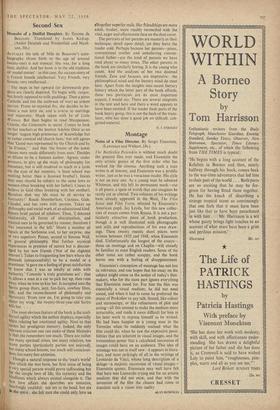Montage
Notes of a Film Director. By Sergei Eisenstein.
• (Lawrence and Wishart, I8s.)
The Battleship Potemkin is without much doubt the greatest film ever made, and Eisenstein the only artistic genius of the first order who has worked for the cinema. Anything such a man writes is of interest, and Eisenstein was a prolific writer, just as he was a voracious reader. His style is not an easy one. As a young man he admired Whitman, and this left its permanent mark—out it all pours, a spate of words that one imagines he rarely cut or altered. Two volumes of his writings have already appeared in the West, The Film Sense and Film Form, selected by Eisenstein's American pupil, Jay Leyda, but this new collec- tion of essays comes from Russia. It is not a par- ticularly attractive piece of book production, though it is well illustrated with photographs and stills and reproductions of his own draw- ings. These twenty mainly short pieces were written between 1932 and 1948, when Eisenstein died. Unfortunately the longest of the essays— those on montage and on Chaplin—will already be familiar to most English readers. Some of the other notes are rather scrappy, and the book leaves one with a feeling of disappointment.
Eisenstein's conception of montage has not lost its relevance, and one hopes that his essay on the subject might come to the notice of today's film-
makers, who for the most part ignore everything that Eisenstein stood for. For him the film was essentially a visual medium; he did not need sound, and when it had to come he preferred the music of Prokofiev to any talk. Sound, like colour and stereoscopy, or like refinements of plot and acting—all this seemed to make the medium more intractable, and made it more difficult for him in his later work to express himself as he wished. He had been happier as a young man in the Twenties when he suddenly realised what the film could do; when he saw the expressive possi- bilities that are inherent in visual images, and the tremendous power that a calculated succession of images could have on an audience. This idea of montage was not in itself new : it appears in litera- ture, and most strikingly of all in the writings of Leonardo da Vinci, whose long description of a deluge—a majestic succession of visual images- Eisenstein quotes. Eisenstein may well have felt that here was Leonardo crying out for an artistic medium that did not exist; and that with the invention of the film the chance had come to translate such a vision into reality.
ALAN IIOWNESS






































 Previous page
Previous page